engine FIAT DOBLO COMBI 2015 2.G User Guide
[x] Cancel search | Manufacturer: FIAT, Model Year: 2015, Model line: DOBLO COMBI, Model: FIAT DOBLO COMBI 2015 2.GPages: 323, PDF Size: 46.77 MB
Page 53 of 323
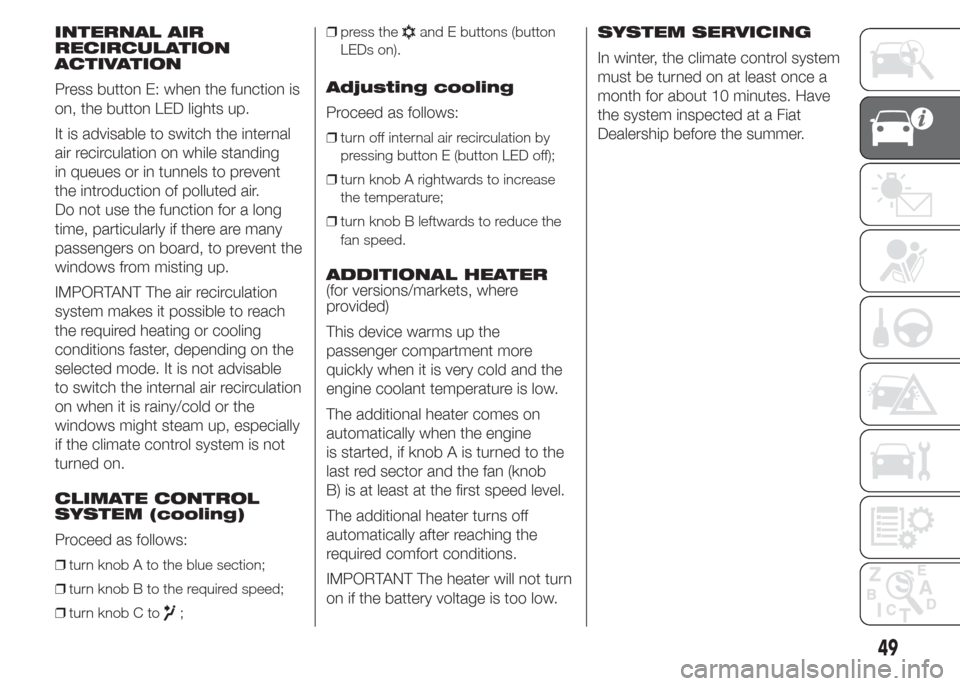
INTERNAL AIR
RECIRCULATION
ACTIVATION
Press button E: when the function is
on, the button LED lights up.
It is advisable to switch the internal
air recirculation on while standing
in queues or in tunnels to prevent
the introduction of polluted air.
Do not use the function for a long
time, particularly if there are many
passengers on board, to prevent the
windows from misting up.
IMPORTANT The air recirculation
system makes it possible to reach
the required heating or cooling
conditions faster, depending on the
selected mode. It is not advisable
to switch the internal air recirculation
on when it is rainy/cold or the
windows might steam up, especially
if the climate control system is not
turned on.
CLIMATE CONTROL
SYSTEM (cooling)
Proceed as follows:
❒turn knob A to the blue section;
❒turn knob B to the required speed;
❒turn knob C to
;❒press the
and E buttons (button
LEDs on).
Adjusting cooling
Proceed as follows:
❒turn off internal air recirculation by
pressing button E (button LED off);
❒turn knob A rightwards to increase
the temperature;
❒turn knob B leftwards to reduce the
fan speed.
ADDITIONAL HEATER
(for versions/markets, where
provided)
This device warms up the
passenger compartment more
quickly when it is very cold and the
engine coolant temperature is low.
The additional heater comes on
automatically when the engine
is started, if knob A is turned to the
last red sector and the fan (knob
B) is at least at the first speed level.
The additional heater turns off
automatically after reaching the
required comfort conditions.
IMPORTANT The heater will not turn
on if the battery voltage is too low.SYSTEM SERVICING
In winter, the climate control system
must be turned on at least once a
month for about 10 minutes. Have
the system inspected at a Fiat
Dealership before the summer.
49
Page 59 of 323
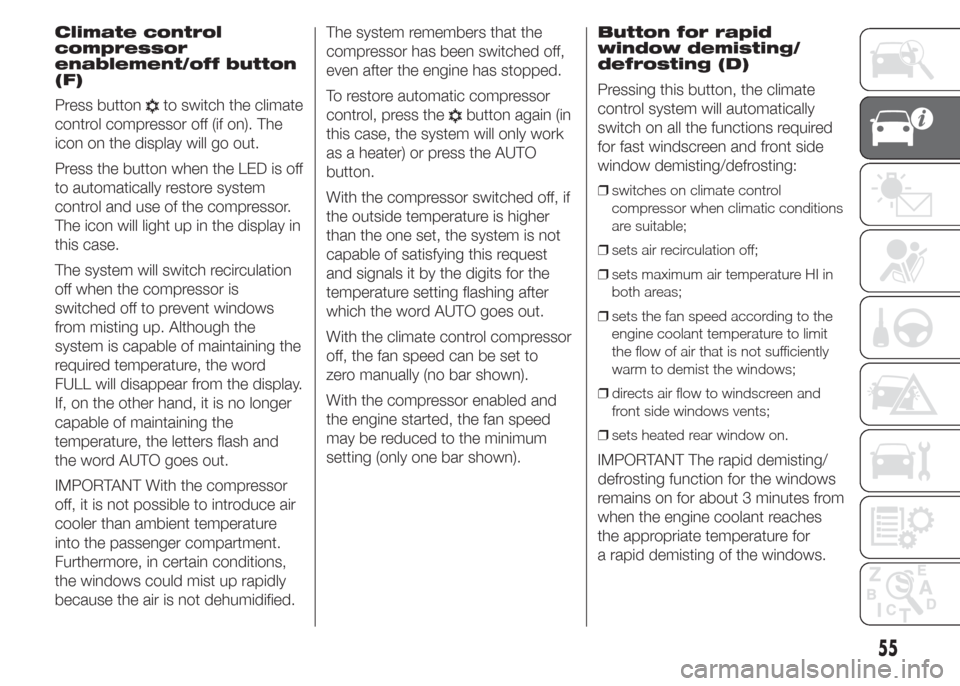
Climate control
compressor
enablement/off button
(F)
Press button
to switch the climate
control compressor off (if on). The
icon on the display will go out.
Press the button when the LED is off
to automatically restore system
control and use of the compressor.
The icon will light up in the display in
this case.
The system will switch recirculation
off when the compressor is
switched off to prevent windows
from misting up. Although the
system is capable of maintaining the
required temperature, the word
FULL will disappear from the display.
If, on the other hand, it is no longer
capable of maintaining the
temperature, the letters flash and
the word AUTO goes out.
IMPORTANT With the compressor
off, it is not possible to introduce air
cooler than ambient temperature
into the passenger compartment.
Furthermore, in certain conditions,
the windows could mist up rapidly
because the air is not dehumidified.The system remembers that the
compressor has been switched off,
even after the engine has stopped.
To restore automatic compressor
control, press thebutton again (in
this case, the system will only work
as a heater) or press the AUTO
button.
With the compressor switched off, if
the outside temperature is higher
than the one set, the system is not
capable of satisfying this request
and signals it by the digits for the
temperature setting flashing after
which the word AUTO goes out.
With the climate control compressor
off, the fan speed can be set to
zero manually (no bar shown).
With the compressor enabled and
the engine started, the fan speed
may be reduced to the minimum
setting (only one bar shown).Button for rapid
window demisting/
defrosting (D)
Pressing this button, the climate
control system will automatically
switch on all the functions required
for fast windscreen and front side
window demisting/defrosting:
❒switches on climate control
compressor when climatic conditions
are suitable;
❒sets air recirculation off;
❒sets maximum air temperature HI in
both areas;
❒sets the fan speed according to the
engine coolant temperature to limit
the flow of air that is not sufficiently
warm to demist the windows;
❒directs air flow to windscreen and
front side windows vents;
❒sets heated rear window on.
IMPORTANT The rapid demisting/
defrosting function for the windows
remains on for about 3 minutes from
when the engine coolant reaches
the appropriate temperature for
a rapid demisting of the windows.
55
Page 60 of 323
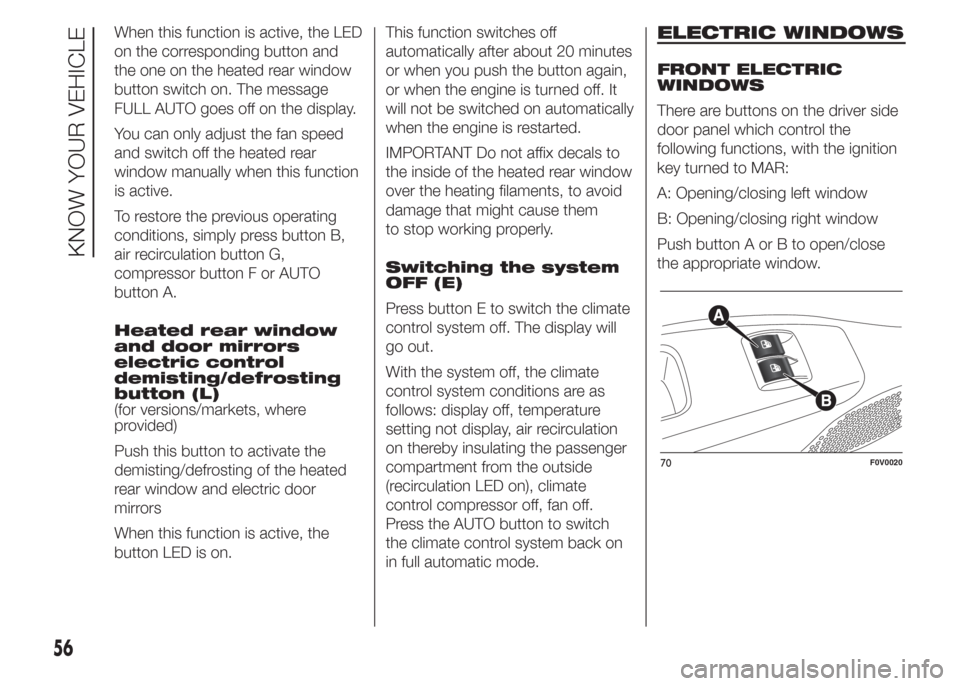
When this function is active, the LED
on the corresponding button and
the one on the heated rear window
button switch on. The message
FULL AUTO goes off on the display.
You can only adjust the fan speed
and switch off the heated rear
window manually when this function
is active.
To restore the previous operating
conditions, simply press button B,
air recirculation button G,
compressor button F or AUTO
button A.
Heated rear window
and door mirrors
electric control
demisting/defrosting
button (L)
(for versions/markets, where
provided)
Push this button to activate the
demisting/defrosting of the heated
rear window and electric door
mirrors
When this function is active, the
button LED is on.This function switches off
automatically after about 20 minutes
or when you push the button again,
or when the engine is turned off. It
will not be switched on automatically
when the engine is restarted.
IMPORTANT Do not affix decals to
the inside of the heated rear window
over the heating filaments, to avoid
damage that might cause them
to stop working properly.
Switching the system
OFF (E)
Press button E to switch the climate
control system off. The display will
go out.
With the system off, the climate
control system conditions are as
follows: display off, temperature
setting not display, air recirculation
on thereby insulating the passenger
compartment from the outside
(recirculation LED on), climate
control compressor off, fan off.
Press the AUTO button to switch
the climate control system back on
in full automatic mode.ELECTRIC WINDOWS
FRONT ELECTRIC
WINDOWS
There are buttons on the driver side
door panel which control the
following functions, with the ignition
key turned to MAR:
A: Opening/closing left window
B: Opening/closing right window
Push button A or B to open/close
the appropriate window.
70F0V0020
56
KNOW YOUR VEHICLE
Page 63 of 323
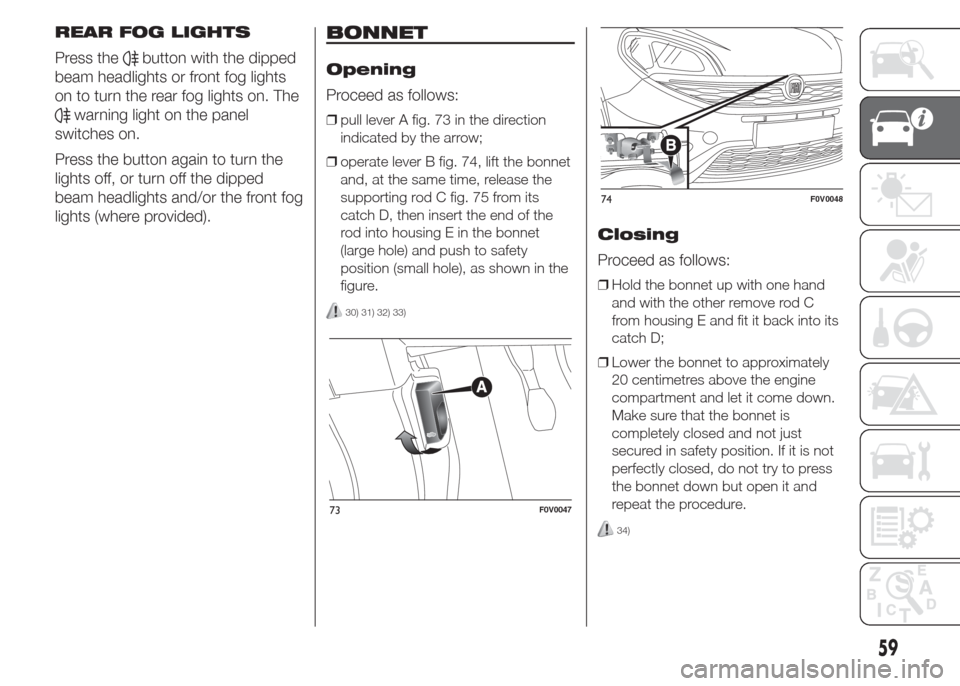
REAR FOG LIGHTS
Press the
button with the dipped
beam headlights or front fog lights
on to turn the rear fog lights on. The
warning light on the panel
switches on.
Press the button again to turn the
lights off, or turn off the dipped
beam headlights and/or the front fog
lights (where provided).
BONNET
Opening
Proceed as follows:
❒pull lever A fig. 73 in the direction
indicated by the arrow;
❒operate lever B fig. 74, lift the bonnet
and, at the same time, release the
supporting rod C fig. 75 from its
catch D, then insert the end of the
rod into housing E in the bonnet
(large hole) and push to safety
position (small hole), as shown in the
figure.
30) 31) 32) 33)
Closing
Proceed as follows:
❒Hold the bonnet up with one hand
and with the other remove rod C
from housing E and fit it back into its
catch D;
❒Lower the bonnet to approximately
20 centimetres above the engine
compartment and let it come down.
Make sure that the bonnet is
completely closed and not just
secured in safety position. If it is not
perfectly closed, do not try to press
the bonnet down but open it and
repeat the procedure.
34)
73F0V0047
74F0V0048
59
Page 64 of 323
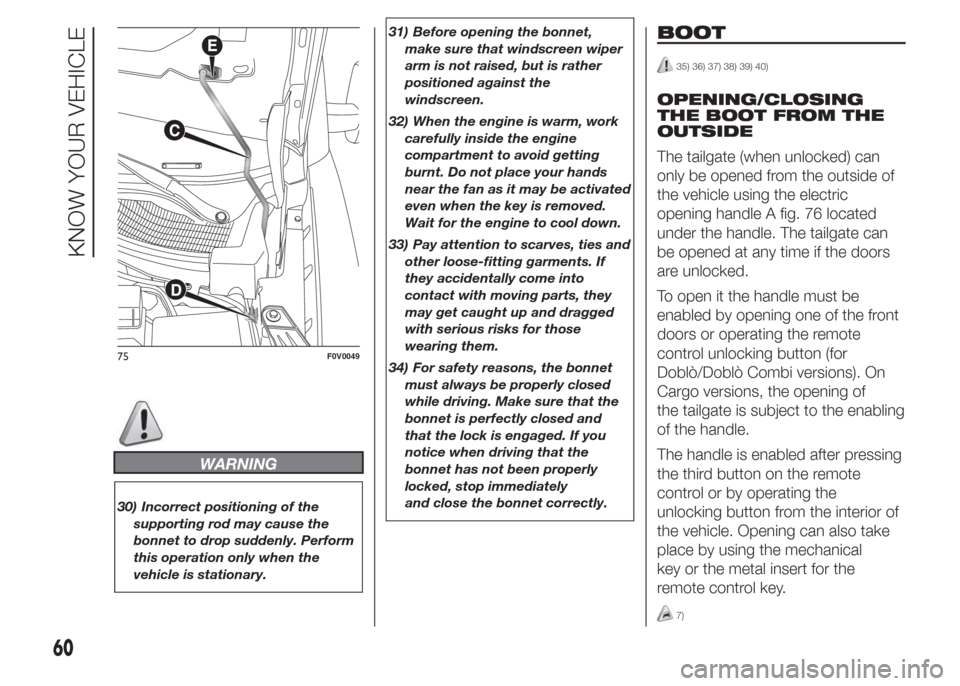
WARNING
30) Incorrect positioning of the
supporting rod may cause the
bonnet to drop suddenly. Perform
this operation only when the
vehicle is stationary.31) Before opening the bonnet,
make sure that windscreen wiper
arm is not raised, but is rather
positioned against the
windscreen.
32) When the engine is warm, work
carefully inside the engine
compartment to avoid getting
burnt. Do not place your hands
near the fan as it may be activated
even when the key is removed.
Wait for the engine to cool down.
33) Pay attention to scarves, ties and
other loose-fitting garments. If
they accidentally come into
contact with moving parts, they
may get caught up and dragged
with serious risks for those
wearing them.
34) For safety reasons, the bonnet
must always be properly closed
while driving. Make sure that the
bonnet is perfectly closed and
that the lock is engaged. If you
notice when driving that the
bonnet has not been properly
locked, stop immediately
and close the bonnet correctly.
BOOT
35) 36) 37) 38) 39) 40)
OPENING/CLOSING
THE BOOT FROM THE
OUTSIDE
The tailgate (when unlocked) can
only be opened from the outside of
the vehicle using the electric
opening handle A fig. 76 located
under the handle. The tailgate can
be opened at any time if the doors
are unlocked.
To open it the handle must be
enabled by opening one of the front
doors or operating the remote
control unlocking button (for
Doblò/Doblò Combi versions). On
Cargo versions, the opening of
the tailgate is subject to the enabling
of the handle.
The handle is enabled after pressing
the third button on the remote
control or by operating the
unlocking button from the interior of
the vehicle. Opening can also take
place by using the mechanical
key or the metal insert for the
remote control key.
7)
75F0V0049
60
KNOW YOUR VEHICLE
Page 75 of 323
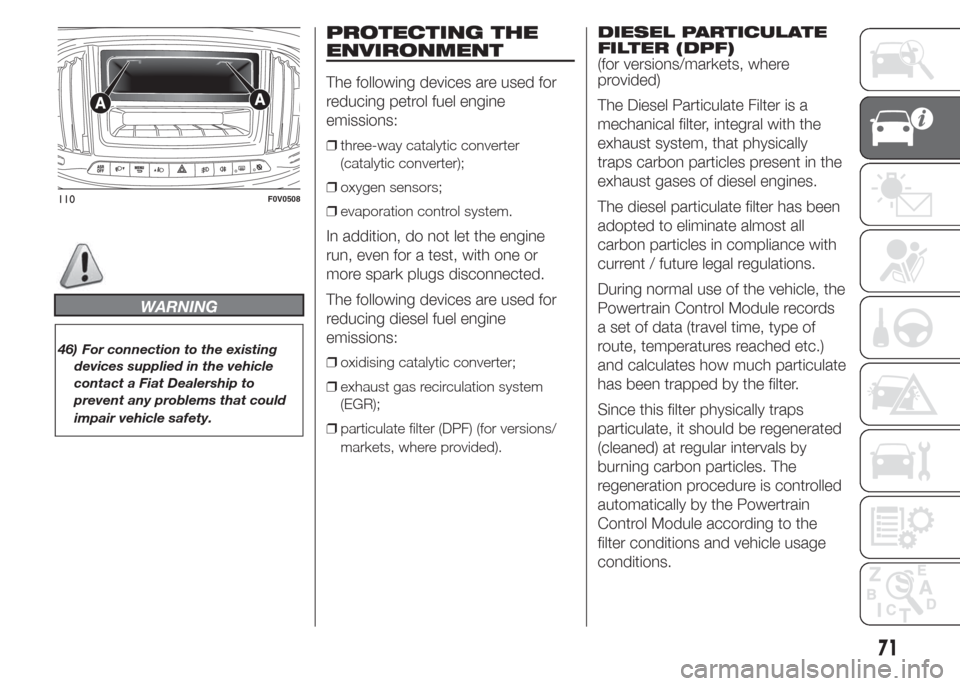
WARNING
46) For connection to the existing
devices supplied in the vehicle
contact a Fiat Dealership to
prevent any problems that could
impair vehicle safety.
PROTECTING THE
ENVIRONMENT
The following devices are used for
reducing petrol fuel engine
emissions:
❒three-way catalytic converter
(catalytic converter);
❒oxygen sensors;
❒evaporation control system.
In addition, do not let the engine
run, even for a test, with one or
more spark plugs disconnected.
The following devices are used for
reducing diesel fuel engine
emissions:
❒oxidising catalytic converter;
❒exhaust gas recirculation system
(EGR);
❒particulate filter (DPF) (for versions/
markets, where provided).
DIESEL PARTICULATE
FILTER (DPF)
(for versions/markets, where
provided)
The Diesel Particulate Filter is a
mechanical filter, integral with the
exhaust system, that physically
traps carbon particles present in the
exhaust gases of diesel engines.
The diesel particulate filter has been
adopted to eliminate almost all
carbon particles in compliance with
current / future legal regulations.
During normal use of the vehicle, the
Powertrain Control Module records
a set of data (travel time, type of
route, temperatures reached etc.)
and calculates how much particulate
has been trapped by the filter.
Since this filter physically traps
particulate, it should be regenerated
(cleaned) at regular intervals by
burning carbon particles. The
regeneration procedure is controlled
automatically by the Powertrain
Control Module according to the
filter conditions and vehicle usage
conditions.
110F0V0508
71
Page 76 of 323
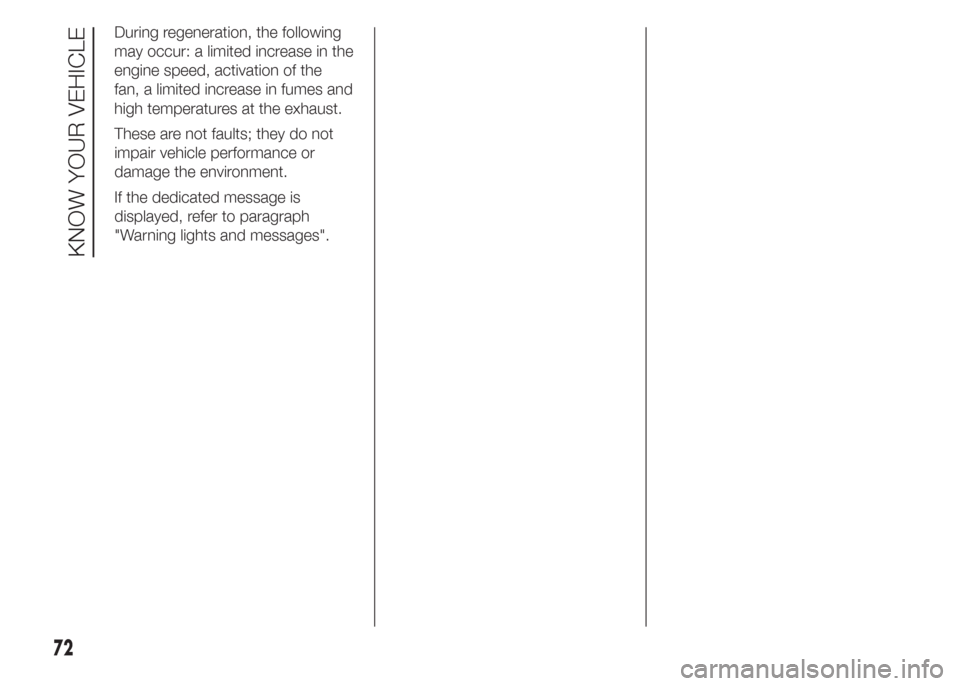
During regeneration, the following
may occur: a limited increase in the
engine speed, activation of the
fan, a limited increase in fumes and
high temperatures at the exhaust.
These are not faults; they do not
impair vehicle performance or
damage the environment.
If the dedicated message is
displayed, refer to paragraph
"Warning lights and messages".
72
KNOW YOUR VEHICLE
Page 77 of 323
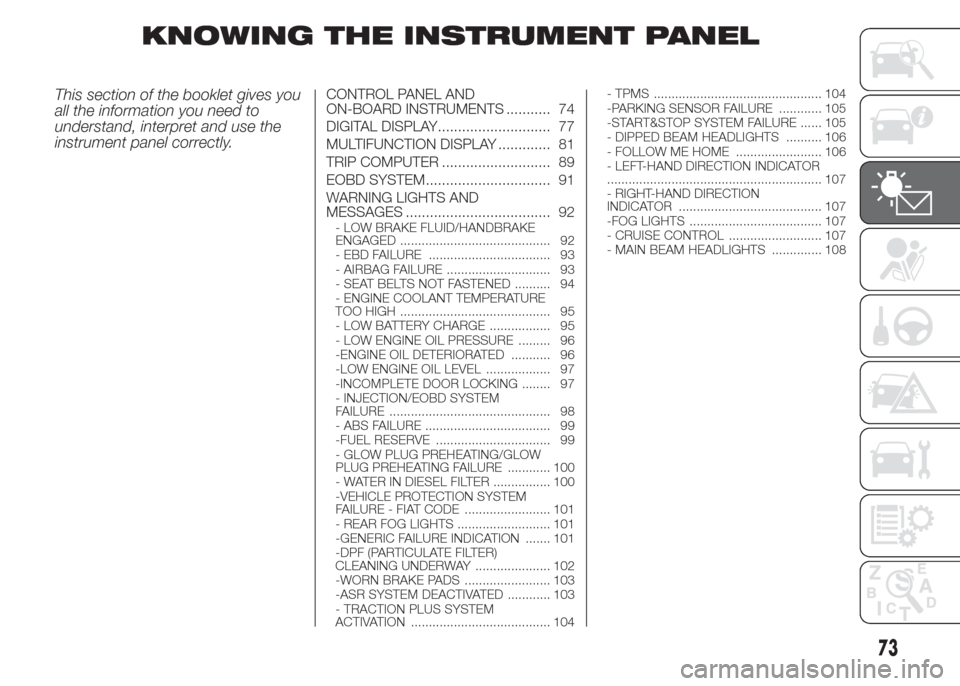
KNOWING THE INSTRUMENT PANEL
This section of the booklet gives you
all the information you need to
understand, interpret and use the
instrument panel correctly.CONTROL PANEL AND
ON-BOARD INSTRUMENTS ........... 74
DIGITAL DISPLAY............................ 77
MULTIFUNCTION DISPLAY ............. 81
TRIP COMPUTER ........................... 89
EOBD SYSTEM............................... 91
WARNING LIGHTS AND
MESSAGES .................................... 92
- LOW BRAKE FLUID/HANDBRAKE
ENGAGED .......................................... 92
- EBD FAILURE .................................. 93
- AIRBAG FAILURE ............................. 93
- SEAT BELTS NOT FASTENED .......... 94
- ENGINE COOLANT TEMPERATURE
TOO HIGH .......................................... 95
- LOW BATTERY CHARGE ................. 95
- LOW ENGINE OIL PRESSURE ......... 96
-ENGINE OIL DETERIORATED ........... 96
-LOW ENGINE OIL LEVEL .................. 97
-INCOMPLETE DOOR LOCKING ........ 97
- INJECTION/EOBD SYSTEM
FAILURE ............................................. 98
- ABS FAILURE ................................... 99
-FUEL RESERVE ................................ 99
- GLOW PLUG PREHEATING/GLOW
PLUG PREHEATING FAILURE ............ 100
- WATER IN DIESEL FILTER ................ 100
-VEHICLE PROTECTION SYSTEM
FAILURE - FIAT CODE ........................ 101
- REAR FOG LIGHTS .......................... 101
-GENERIC FAILURE INDICATION ....... 101
-DPF (PARTICULATE FILTER)
CLEANING UNDERWAY ..................... 102
-WORN BRAKE PADS ........................ 103
-ASR SYSTEM DEACTIVATED ............ 103
- TRACTION PLUS SYSTEM
ACTIVATION ....................................... 104- TPMS ............................................... 104
-PARKING SENSOR FAILURE ............ 105
-START&STOP SYSTEM FAILURE ...... 105
- DIPPED BEAM HEADLIGHTS .......... 106
- FOLLOW ME HOME ........................ 106
- LEFT-HAND DIRECTION INDICATOR
............................................................ 107
- RIGHT-HAND DIRECTION
INDICATOR ........................................ 107
-FOG LIGHTS ..................................... 107
- CRUISE CONTROL .......................... 107
- MAIN BEAM HEADLIGHTS .............. 108
73
Page 78 of 323
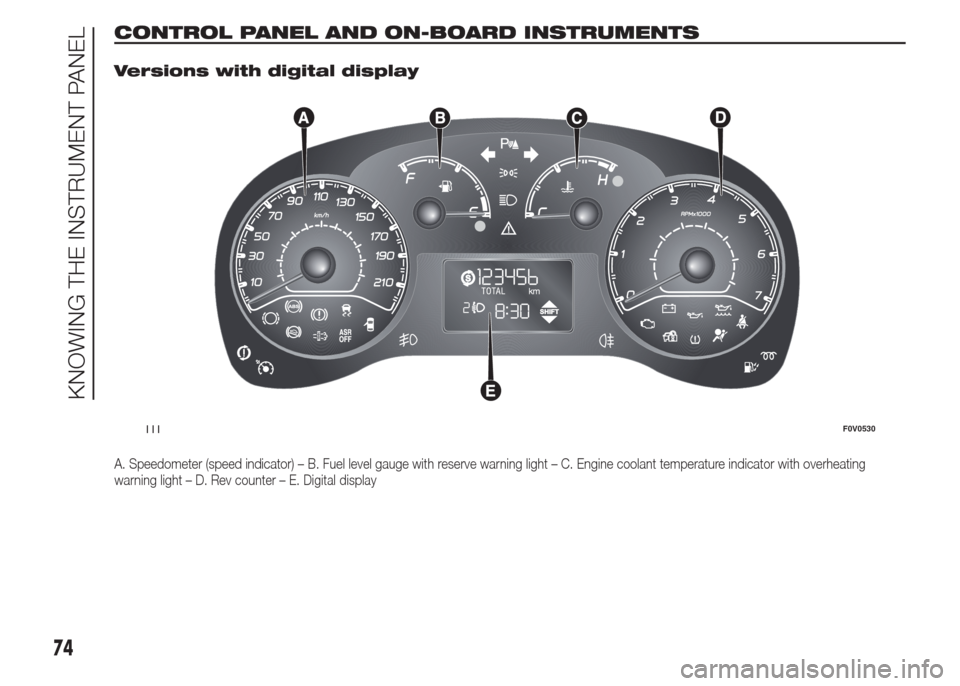
CONTROL PANEL AND ON-BOARD INSTRUMENTS.
Versions with digital display
A. Speedometer (speed indicator) – B. Fuel level gauge with reserve warning light – C. Engine coolant temperature indicator with overheating
warning light – D. Rev counter – E. Digital display
111F0V0530
74
KNOWING THE INSTRUMENT PANEL
Page 79 of 323
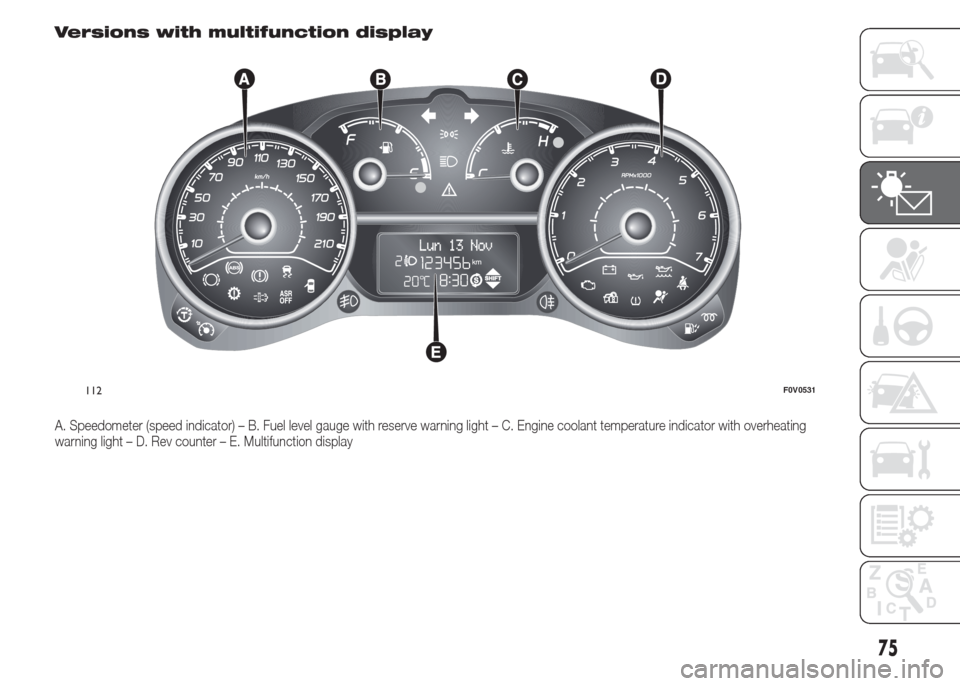
Versions with multifunction display
A. Speedometer (speed indicator) – B. Fuel level gauge with reserve warning light – C. Engine coolant temperature indicator with overheating
warning light – D. Rev counter – E. Multifunction display
112F0V0531
75